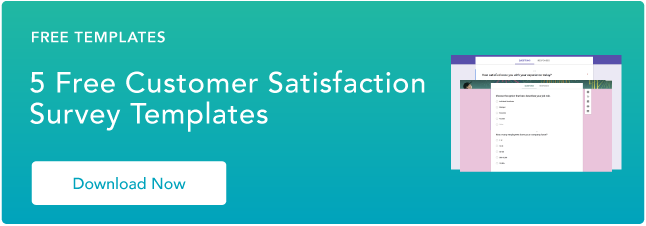In the 2000 film What Women Want, Mel Gibson's character (an advertising executive) gains the uncanny ability to read women's thoughts -- a power he quickly uses to his advantage.

For marketers, this sounds like a dream come true.
After all, wouldn't it be amazing to be able to read all of your customers' minds (both men and women)? To know exactly what they want, and what they think of your business?
The good news is that you don't have to become a mind-reader to gain these insights. Instead, you can learn what you're doing well (and what you need to change) by asking your customers directly.
Of course, asking a question and actually getting helpful feedback are two entirely different matters. To get real, actionable insights, you need to increase your feedback response rates, and know what to do with that information once you get it.
Whether you're trying to measure customer satisfaction or test the usability of your website, it can be all too easy to get bogged down by individual statements -- and these aren't always the most reliable. People say one thing and do another.
If you're not careful, asking the wrong type of question can lead to so many varied, open-ended responses that you can't gain any meaningful insights.
Instead, you need to look at the big picture.
Customer feedback must be data-driven if you wish to improve services, increase your retention rate and make smarter business decisions. Data-driven companies are"23X more likely to acquire customers [and] 6X as likely to retain those customers."
Using data to look at the big picture allows you to obtain a more accurate assessment of customer perceptions. But to get the data that will lead you to these insights, you need to start by asking for feedback in the right ways.
How to Ask for Customer Feedback
1. Email
Email is one of the most popular methods for requesting feedback, and for good reason. It's simple to use, doesn't cost much, and generally has a good open rate, with the average across all industries coming in around 32%.
To be truly effective, email feedback requests need to be kept short and sweet. You'll likely only be able to ask one or two specific questions -- any more, and you'll reduce your chances of getting a response.
Email is best used to get feedback about a specific transaction or customer service experience, rather than a broad overview of how someone perceives your brand.
2. Phone Calls
When trying to collect more personalized, qualitative data, phone surveys can prove especially helpful. Many people feel more comfortable talking about their feelings than writing them down, and tone of voice can communicate much more than words alone.
Keep in mind, however, that few people enjoy receiving an unsolicited marketing-related phone call. Calling your customers out of the blue is unlikely to get you very much feedback.
Instead, successful companies ask for feedback during a support or success call. In these situations, the customer either initiated the call themselves or already agreed to speak to a company representative.
Framing the survey around the recent customer experience -- and promising that it will only take a few minutes -- will encourage customers to stay on the line.
3. Surveys
Whether delivered through an email link or a pop-up request on your website, surveys are usually what we think of first when trying to solicit feedback from customers. Unfortunately, far too many surveys go unfinished or get low-quality results because they are too long and customers lose interest.
As with email feedback requests, keeping your surveys short can greatly improve response rates. Only include questions that are relevant to what you wish to analyze. Offer a mix of open-ended and multiple-choice selections to help users save time and share personal opinions.
Small businesses can also benefit by personalizing their survey requests.
As noted by the Huffington Post's Young Entrepreneur Council, small businesses can"send people a personal email with the link to the survey. Clearly explain why the survey is important and why you value their feedback."
This simple action can help customers feel more valued and increase their interest in responding.
Tools to Collect Customer Feedback
Getting quality feedback is a lot easier if you have the right tools in your arsenal -- and you don't always have to rely on asking direct questions of your customers to gain helpful insights, either.
Here are some of the best tools for getting customer feedback:
1. Hotjar
Hotjar uses heat maps, recordings and conversion funnels to help you better understand how visitors use your site and what obstacles are preventing them from making a purchase -- without the need for asking direct questions. It provides similar services for your online forms and surveys so you can improve future feedback asks, and also helps you recruit test users for your site.
2. SurveyMonkey
SurveyMonkey remains one of the best-known survey providers, and for good reason. With customizable pre-written templates, you can finish creating a survey in a matter of minutes. SurveyMonkey will then help you distribute your surveys via email, social media and more, and even help you dig into the results.
3. Google Optimize
A/B testing is one of the best ways to gain customer insights without directly asking for feedback, and that's where Google Optimize can make a difference. Google Optimize allows you to run A/B tests, multivariate tests and redirect tests through a visual editor so you can determine which site options best meet your goals. Paired with Google Analytics, this tool makes it easy to identify which site alterations best fit the needs of your customers.
4. HubSpot
HubSpot has a variety of tools that make it easy for you to connect with customers to get their feedback. Free tools like Conversations allow you and your team to sync up your customer communications across different channels, like live chat and social media and email, and paid tools like Customer Feedback let you deploy customer surveys and track your results over time.
3 Strategies for Increasing Customer Feedback Response Rates
Using the right tools and outreach methods is an important beginning for increasing your response rates, but these resources aren't always enough on their own.
Quite often, you'll need to provide a little extra motivation to get customers to give you the information you want. Here are three strategies you can start using today:
1. Use an incentive.
Time is money -- and many customers aren't going to be willing to provide feedback if there isn't something in it for them. Because of this, award-driven feedback is one of the best ways to encourage customers to share their thoughts and opinions -- and few awards are more enticing than a product discount or other special offer.
Studies have found that emails containing coupons have unique open and unique click rates 14% and 34% higher, respectively, than emails without a coupon.
These coupons and special offers don't even have to be directly related to your business. For example, many dental offices incentivize customers with free movie tickets or gift cards to local retailers to encourage online reviews and referrals.
Non-monetary incentives can also be effective, depending on your industry. This could include gifts like a free pen or even a charitable contribution made by your company. You could even offer invites to special events.
2. Know your customer demographic.
An understanding of your customer demographic and their interests should be one of the biggest influencers in how you seek feedback and the type of incentives you offer.
Relevancy is crucial in selecting a quality reward, and you should strive to make your incentive relevant to your entire customer base.
For example, a tree services company might try to incentivize its survey by offering a coupon for 20% off their tree removal services. While this could motivate some customers, it wouldn't do much for those who only go to the company for pruning and other basic care.
The better you know your customers, the easier it will be to tailor your incentives to their wants and interests. Use the knowledge you've gained from other marketing endeavors to make a smart pick.
3. Ask at the right time.
Understanding your customers isn't the be-all end-all in choosing which rewards you wish to offer. After all, you don't have a limitless budget for your survey.
You should also make sure that the incentive reflects the time commitment and value of the feedback request. A $50 gift card is overly generous for a five-minute questionnaire, but it could be appropriate when someone refers a new customer to you.
In many cases, you may not need to offer an actual incentive at all.
Asking questions at the right time during a buyer's journey (such as immediately after they finish a transaction) requires little effort, and so the customer may be willing to provide feedback without any external reward.
When you make these feedback requests a seamless, simple follow up to many customer actions, they'll be more likely to respond without driving up your marketing expenses.
Even with these strategies in place, you're not likely to get feedback responses from every customer. That's okay. As you increase response rates and take steps to ensure you get quality feedback, you'll have access to more reliable data, enabling you to make smarter business decisions in the future.
You'll even have a better understanding of the demographics your company caters to.
By making the right ask of your customers, you will get the responses you need to help you reach your company goals.
To learn more, read these examples of funny customer feedback.
![→ Free Download: 5 Customer Survey Templates [Access Now]](https://no-cache.hubspot.com/cta/default/53/9d36416b-3b0d-470c-a707-269296bb8683.png)








![‘How Did You Hear About Us’ Survey Options: All-In-One Guide [+ Examples]](https://www.hubspot.com/hubfs/how%20did%20you%20hear%20about%20us_featured.jpg)
![How to Write an Apology Letter to Customers [12 Templates & Examples]](https://www.hubspot.com/hubfs/ai%20customer%20service%20predictions%20%286%29.png)
